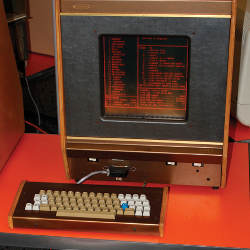
In early June, the Computer History Museum hosted the PLATO@50 Conference to mark the 50-year anniversary of the computer system that many credit with presaging the networked world of social media and interactive education that has become a mainstay of contemporary culture. More than 400 computing enthusiasts attended the event, the highlight of which was a moderated discussion between Don Bitzer, the inventor of PLATO, and Ray Ozzie, Microsoft’s chief software architect.
The event included several presentations and a reunion of PLATO alumni from across the U.S. As a special part of the conference, functioning PLATO terminals were set up in an interactive “PLATO playground” for use by conference participants. The terminals included many of the original PLATO games, such as Avatar and Empire, and an array of social media content preserved from the original PLATO databases.
“PLATO@50 was an important event for the museum to convene,” says John Hollar, president of the Mountain View, CA-based museum. “It traced the history of a system that produced the forerunners to an amazing array of technologies—hardware, software, and applications—that live on today, either in original or derivative form.” The conference, says Hollar, highlighted how PLATO in the Computer-based Education Research Laboratory (CERL) at the University of Illinois at Urbana-Champaign produced an accomplished group of alumni, including Ray Ozzie, whose initial design for Lotus Notes derived from PLATO Notes, and Marc Andreessen, the co-author of Mosaic and founder of Netscape.
In addition to keynote speeches and moderated discussions, PLATO@50 documented an array of events that occurred at CERL from its inception in 1967 to its closing in 1994. “That story is important to tell,” says Hollar. “The conference paid tribute to a culture of innovation and openness fostered by Don Bitzer that clearly had an impact on a large number of engineering and computer science majors who passed through CERL and the University of Illinois.” One such alumnus is Marc Andreessen, who considers himself fortunate to be a product of that environment.
“Exploring the history of PLATO and the wild story of the people who designed, built, and used it will enrich everyone’s overall perspective on the world’s embrace of the Internet and computers today,” says Brian Dear.
In computing history, the story of this educational computer system is little known outside of the circles of people who either directly used the system or helped to build it. Invented by Bitzer in 1960, PLATO, an acronym for Programmed Logic for Automated Teaching Operation, began as a project at the University of Illinois at Urbana-Champaign and was eventually commercialized in the 1970s by Control Data Corporation. Over the years, the system developed into a sophisticated, networked computing infrastructure consisting of smart terminals that could run games, chat rooms, and courseware. It was used for education and training by many schools and universities, corporations, and by several branches of the U.S. government, including the military.
Brian Dear, the conference’s primary organizer, worked on PLATO as a programmer, analyst, and courseware designer from 1979 to 1984. “I was amazed by the system and completely ignored the microcomputer revolution going on at the time because here was a computer that was all about connecting people, whereas micros were lonely islands of BASIC programmers and spreadsheet enthusiasts,” he says. “I loved Steve Levy’s Hackers: Heroes of the Computer Revolution, but where is volume two about the other heroes of the computer revolution—namely, the PLATO people?”
Dear, whose book on PLATO, titled The Friendly Orange Glow, is due later this year, says PLATO was far ahead of its time with gas-plasma, flat-panel displays sporting touch screens in 1972. “Nobody else had that,” he says. “PLATO was ahead of everyone by years, and deserves far more credit than it has gotten.”
Sheldon Hochheiser, institutional historian for the IEEE History Center at Rutgers University, offers a similar perspective. “Bitzer’s work was, to my mind, a true innovation and far ahead of its time,” says Hochheiser. “He put together a package of existing and invented technology with educational pedagogy to develop a new way of instruction, whose descendents have spread far and wide.”
While the mainstream technical media focuses on the history of online communities largely through studying the birth of the Internet by way of ARPANET and its descendents, Dear maintains that approach misses an extraordinary segment of the computer history timeline. “PLATO for years served as an excellent predictor for how the Internet would evolve, and its impact is everywhere,” he says. “Exploring the history of PLATO and the wild story of the people who designed, built, and used it will enrich everyone’s overall perspective on the world’s embrace of the Internet and computers today.”




Join the Discussion (0)
Become a Member or Sign In to Post a Comment